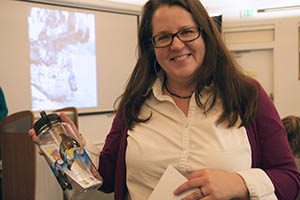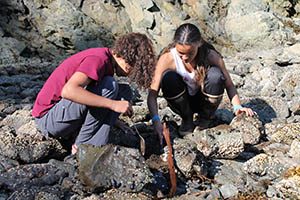By Lisa Matlock
Outreach Coordinator
 Since 2009, the council has partnered with the Chugach Children’s Forest to help youth from the Exxon Valdez oil spill region connect to Prince William Sound directly through unique outdoor experiences. The council has co-sponsored multiple expeditions in which students from Cordova to Kodiak ply the waters of Prince William Sound by kayak, charter vessel, and ferry. The wonders of the Sound, its wildlife, its communities, and its beauty have touched them all, and along the way these youth have learned how the Exxon Valdez oil spill affected this special place and how they can be part of preventing future spills.
Since 2009, the council has partnered with the Chugach Children’s Forest to help youth from the Exxon Valdez oil spill region connect to Prince William Sound directly through unique outdoor experiences. The council has co-sponsored multiple expeditions in which students from Cordova to Kodiak ply the waters of Prince William Sound by kayak, charter vessel, and ferry. The wonders of the Sound, its wildlife, its communities, and its beauty have touched them all, and along the way these youth have learned how the Exxon Valdez oil spill affected this special place and how they can be part of preventing future spills.
The Chugach Children’s Forest, itself a partnership between the Chugach National Forest and the non-profit organization, Alaska Geographic, introduces diverse, young Alaskans to their wild backyard. One of the Children’s Forest’s goals is to “address the critical challenges of people’s growing disconnect from nature paired with mounting impacts on our natural world” and to “bring together communities, educators, land management agencies, and environmental and social non-profits to offer a wide range of innovative programs.”
Youth expedition
As part of our efforts to involve the next generation in the council’s mission, we have helped sponsor an annual six-day discovery expedition into Prince William Sound for middle schoolers with the Children’s Forest. Students from rural communities in the council’s region and urban Anchorage, learn from each other’s widely differing perspectives while experiencing the wild marine environment aboard the M/V Babkin.
 “The council’s network of volunteers and partners in these small communities help make recruitment of the participants in the expeditions possible,” said Ann Mayo-Kiely, program director for Alaska Geographic.
“The council’s network of volunteers and partners in these small communities help make recruitment of the participants in the expeditions possible,” said Ann Mayo-Kiely, program director for Alaska Geographic.
The expedition’s science instructor, Kate Alexander Morse, is a council volunteer from Cordova who also works for the Copper River Watershed Project. According to Mayo-Kiely, Morse’s personal connections to and great knowledge of Prince William Sound and the council’s work “help bring the Sound to life for the kids.”
“Morse engages youth with creative and hands-on activities that increase awareness of the Sound and threats to its health in order to empower these student citizens to raise their own voices in advocating for this place,” added Mayo-Kiely.
Throughout the expedition, youth participants explore the Sound’s marine and rainforest ecosystems and how the ocean, glaciers, and people interact with the ecosystems. When possible, the expedition includes a visit to Alyeska’s Ship Escort and Response Vessel System to learn about oil spill prevention and response, with an eye toward protecting the most sensitive sites in the Sound.
Teacher expedition
Along with the youth expedition, the council also supports a teacher expedition, which is co-led by the Chugach National Forest’s wilderness ranger, Tim Lydon. Eight teachers from the council’s region and all over the state kayak for six days in the western Sound, learning about how to bring the ecology and history of Prince William Sound into their own classrooms. At the end of these expeditions, participant teachers develop lessons that are shared with the council for potential inclusion in the Alaska Oil Spill Curriculum.
“Being immersed in the beauty of Prince William Sound revealed what all of us stand to lose if we fail to incorporate relevant place-based education for our students,” said Susan Stotz, a teacher who participated in the 2014 expedition.
The council’s partnership with the Chugach Children’s Forest originated with Linda Robinson, the council’s former outreach coordinator and current volunteer for the Information and Education Committee.
“The council realized the importance of involving youth in promoting our mission,” said Robinson. “We decided the most effective way to do this would be to collaborate with other organizations that work with youth to incorporate education on oil spills but more importantly, provide information in how, as citizens, we can work toward prevention and response to protect our backyard.”
This project is one of the important ways the council works with our partners to help develop the next generation of citizens who will keep the Sound protected from oil spills.